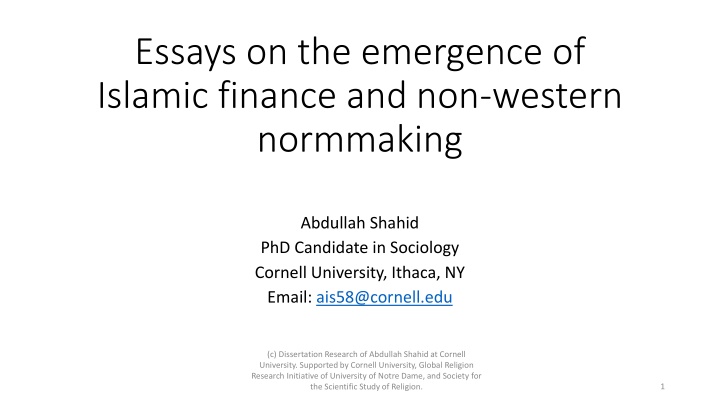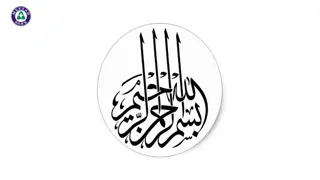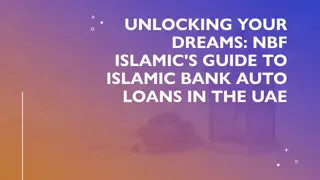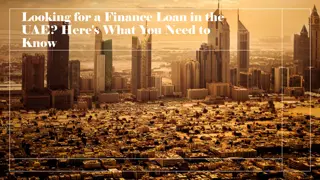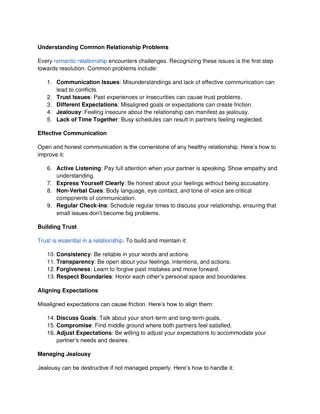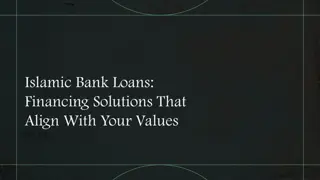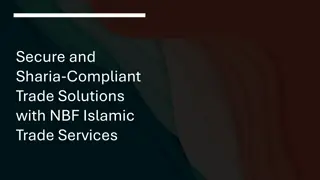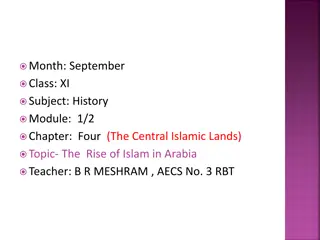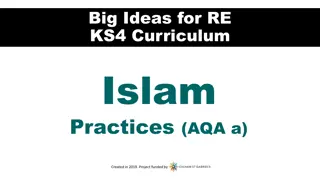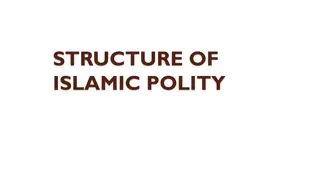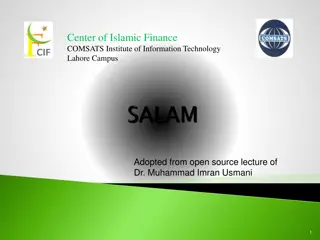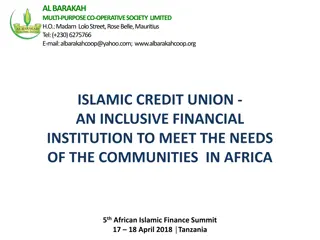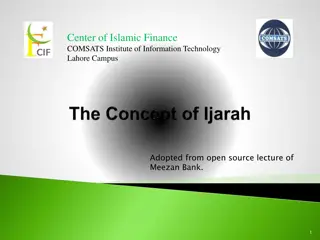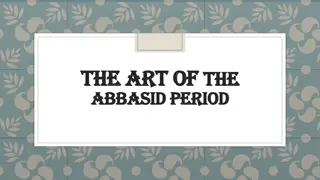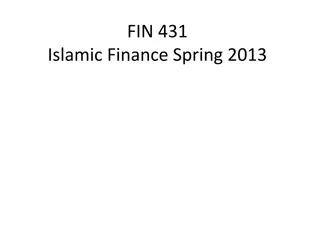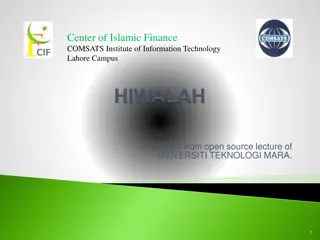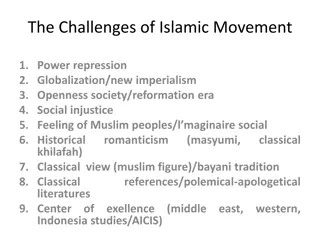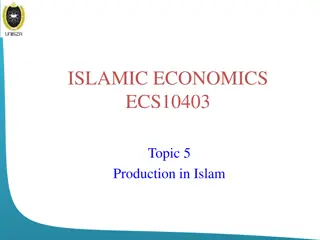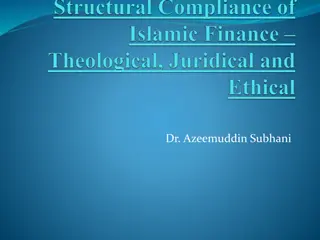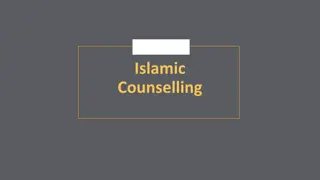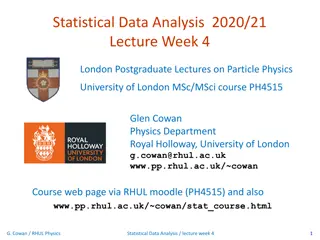Emergence of Islamic Finance: Dynamics and Hypotheses
Exploring the emergence of Islamic finance and non-western norm-making through the research of Abdullah Shahid, a PhD candidate at Cornell University. The study delves into the dynamics of Islamic development financing, the context of the Islamic Development Bank, and various hypotheses related to financial capacity, legal regimes, and Muslim-majority countries.
Download Presentation

Please find below an Image/Link to download the presentation.
The content on the website is provided AS IS for your information and personal use only. It may not be sold, licensed, or shared on other websites without obtaining consent from the author.If you encounter any issues during the download, it is possible that the publisher has removed the file from their server.
You are allowed to download the files provided on this website for personal or commercial use, subject to the condition that they are used lawfully. All files are the property of their respective owners.
The content on the website is provided AS IS for your information and personal use only. It may not be sold, licensed, or shared on other websites without obtaining consent from the author.
E N D
Presentation Transcript
Essays on the emergence of Islamic finance and non-western normmaking Abdullah Shahid PhD Candidate in Sociology Cornell University, Ithaca, NY Email: ais58@cornell.edu (c) Dissertation Research of Abdullah Shahid at Cornell University. Supported by Cornell University, Global Religion Research Initiative of University of Notre Dame, and Society for the Scientific Study of Religion. 1
Paper 1: Dynamics of Islamic Development Financing Abdullah Shahid PhD Candidate in Sociology Cornell University, Ithaca, NY Email: ais58@cornell.edu (c) Dissertation Research of Abdullah Shahid at Cornell University. Supported by Cornell University, Global Religion Research Initiative of University of Notre Dame, and Society for the Scientific Study of Religion. 2
Context Islamic Development Bank (IDB) was founded in 1975 (in Jeddah, Saudi Arabia). IDB provides development financing to countries. The financing instruments of IDB are compatible with Islamic shariah (i.e., Islamic finance). IDB aims to serve the triple agenda of (i) supporting Muslim communities, (ii) promoting Islamic finance, (iii) making sound financial investments. (c) Dissertation Research of Abdullah Shahid at Cornell University. Supported by Cornell University, Global Religion Research Initiative of University of Notre Dame, and Society for the Scientific Study of Religion. 3
Hypotheses Rational economic explanation H1: Islamic development financing would be higher in countries with better financial capacity. According to this explanation countries with (i) greater GDP growth, (ii) higher credit rating, and (iii) higher financial development should receive larger external financial including Islamic developing financing. The idea is to invest in countries that can eventually pay back or has the social and economic infrastructure to make best use of the money. H2: Islamic development financing would be higher in common law regimes. A strand of literature argues that the origin of law affects the external finance and financial development of a country. The common law regimes are arguably more flexible to allow financial changes and newer financial instruments. Hence, common law countries are more likely to adopt Islamic financial instruments, including Islamic development finance. (c) Dissertation Research of Abdullah Shahid at Cornell University. Supported by Cornell University, Global Religion Research Initiative of University of Notre Dame, and Society for the Scientific Study of Religion. 4
Hypotheses (contd) Sociology & International Political Economy Explanations H3: Islamic development financing would be higher in Muslim majority countries. This is consistent with legitimacy explanation. Here, Islamic financial instruments would fulfill the financing needs of the Muslims across various dimensions of legitimacy cognitive, normative, and regulative sense. But what community to serve? Are all Muslim majority countries and communities alike? Countries and communities differ with respect to their Islamic jurisprudence, to say the least. Such juridical differences may have different levels of acceptance to Islamic finance. The Muslim majority former British colonies may have resurgence of their Islamic traditions in the post colonization era and are more likely to receive Islamic financing. Besides, the relationship and similarities with the dominant founding countries (e.g., Saudi Arabia) can be a significant factor in receiving Islamic development financing. H4: Islamic development financing would be higher in countries that have more Sunni over Shia population. H5: Islamic development financing would be higher in countries that have adopted Arabic as the official language. H6: Islamic development financing would be higher in countries that are Muslim majority former British colonies. H7: Islamic development financing would be higher in countries that vote like Saudi Arabia in the United Nations. H8: Islamic development financing would be higher in countries that are geographically near to Saudi Arabia. (c) Dissertation Research of Abdullah Shahid at Cornell University. Supported by Cornell University, Global Religion Research Initiative of University of Notre Dame, and Society for the Scientific Study of Religion. 5
Hypotheses (contd) Sociology & International Political Economy Explanations But the process of extending Islamic development finance may not be either entirely economic (as suggested earlier) or entirely cultural and political. There may be emulation following the broader development financial models (like World bank and International Monetary Fund). Also, the development funds may flow in countries through being contiguous to countries that have already received such funding. H9: Islamic development financing would be higher in countries that have recently received higher World Bank financing. H10: Islamic development financing would be higher in countries that have recently received higher International Monetary Fund financing. H11: Islamic development financing would be higher in countries that have higher proportion of neighboring countries with previous Islamic development funding. (c) Dissertation Research of Abdullah Shahid at Cornell University. Supported by Cornell University, Global Religion Research Initiative of University of Notre Dame, and Society for the Scientific Study of Religion. 6
Empirical Methods and Data Method 1: Panel Data Fixed Effects Regressions Unit of Analysis: Country-year observations, 188 countries in total, year 1976 2016 Dependent Variable: Islamic development (IDB) funding in countries (log transformed) Explanatory Variables (lagged by a year to account for endogeneity, as applicable): gdp growth rate, financial development (index from IMF), credit rating (continuous variable) common law (1= common law, 0 = else), Muslim majority (1 = the country is Muslim majority, 0 = else), Muslim majority British colony (1= the country is a Muslim majority former British colony, 0 = else), Sunni over Shia (1 = Sunni population > Shia, 0 = else), Arabic official language (1= Arabic as official language, Similarity to Saudi Arabia in United Nations voting (continuous measure of cosine similarity), Distance from Saudi Arabia (log transformed continuous value miles/km), World bank financing (log transformed), IMF financing (log transformed), proportion of contiguous countries that have received IDB funding in countries. Controls: Distance from USA, English as official language, French as official language, Similarity to USA in United Nations voting, globalization of a country (KOF index). Year fixed effects, country fixed effects Several variables had imputed country-years based on available country years. Details of imputations are available upon request. (c) Dissertation Research of Abdullah Shahid at Cornell University. Supported by Cornell University, Global Religion Research Initiative of University of Notre Dame, and Society for the Scientific Study of Religion. 7
Empirical Methods and Data Method 2: difference in difference analysis Various difference-in-difference analyses. Treatment year: 1991 (Gulf War). The variable defined as Post 1991 Year (1 for post 1991 years, 0 for pre 1991 years). Treatment groups: Gulf War Coalition (=1): The countries that joined the Gulf war coalition of Saudi Arabia. Sunni Gulf War (=1): The countries that have Sunni over Shia majority and joined the Gulf war coalition of Saudi Arabia. Muslim Gulf (=1): The Muslim Majority countries that joined the Gulf war coalition of Saudi Arabia. Control groups: Gulf War Coalition = 0: The countries that DID NOT join the Gulf war coalition of Saudi Arabia Sunni Gulf War =0 : Any countries for which Sunni Gulf War 1 Muslim Gulf = 0: Any countries for which Muslim Gulf 1 Same unit of analysis and other variables as Method 1 Country and year fixed effects. (c) Dissertation Research of Abdullah Shahid at Cornell University. Supported by Cornell University, Global Religion Research Initiative of University of Notre Dame, and Society for the Scientific Study of Religion. 8
Method 1 Results: Table 1 Model 1 -0.002 0.007** -0.719*** 0.009*** Model 2 -0.003 0.008** Model 3 -0.002 0.007** -0.719*** Model 4 -0.002 0.007** -0.719*** 0.009*** Model 5 -0.003 0.007** -0.746*** Model 6 -0.002 0.007** -0.381* Model 7 -0.002 0.007** -0.381* DV: IDB investment World Bank investment IMF credit Financial development GDP growth Credit risk Distance from Saudi Arabia Distance from USA Common law Muslim majority British colony Arabic official language English official language French official language UN voting similarity to Saudi Arabia UN voting similarity to USA Globalization Sunni over Shia majority IDB projects in neighboring countries Constant Country fixed effects Time (year) fixed effects N R-squared F stat 0.009**** 0.009*** 0.007*** 0.013*** -0.472 -0.937 0.221 0.647** 0.938 -0.241 0.318 -1.713 0.007*** 0.013*** -0.722 -0.796 0.423 0.647** 0.269 -0.344 0.442 -2.653 -0.351 -0.001 0.173*** 0.211** 14.019 Yes Yes 7,304 0.640 53.26*** (236, 7067) .015*** -1.64 -8.403* -0.931 -7.282* 0.626 0.569** -0.856 -4.958 -0.857 -7.204 0.547 0.575** -0.660 0.333 -1.538 -0.507 0.569** 3.060** 4.055* 0.569** -15.145* 0.636 0.678** -0.881 -23.243* 3.755 0.968 2.973 -4.594 0.002 0.042*** 0.191** 76.80* Yes Yes 7,304 0.638 53.01*** (235, 7068) -0.001 0.173*** 0.211*** 12.617 Yes Yes 7,304 0.640 53.26*** (236, 7067) 0.155*** 0.189** 85.51* Yes Yes 7,304 0.638 53.24*** (234, 7069) 0.177*** 0.206** 14.36 Yes Yes 7,304 0.6398 53.66** (234, 7069) 0.155*** .189** 10.192 Yes Yes 7,304 0.638 53.24*** (234, 7069) 0.155*** 0.189** 78.39* Yes Yes 7,304 0.638 53.24** (234, 7069) Degrees of freedom *p<.05, **p<.01, ***p<.001 (c) Dissertation Research of Abdullah Shahid at Cornell University. Supported by Cornell University, Global Religion Research Initiative of University of Notre Dame, and Society for the Scientific Study of Religion. 9
Method 2 Results (for Gulf War Coalition Treatment and Control): Table 2 DV: IDB investmnent Post 1991 year Gulf War Coalition Post 1991 Year * Gulf War Coalition Muslim majority World Bank investment IMF credit Financial development GDP growth Credit risk Distance from Saudi Arabia Distance from USA Common law Muslim majority British colony Arabic official language English official language French official language UN voting similarity to Saudi Arabia UN voting similarity to USA Globalization Sunni over shia majority IDB projects in neighboring countries Constant Country fixed effects Time (year) fixed effects N R-squared Degrees of freedom F-Stat Model 1 0.954*** 1.059* 0.659*** Model 2 0.941*** -0.024 0.676*** 1.092*** 0.005 0.009*** -1.384*** 0.007*** Model 3 0.759*** -0.762 0.686*** 1.138*** 0.006 0.01*** -0.987*** 0.005** 0.015*** 0.295 0.063 -0.211 -0.769** 1.833 0.242 -0.397 -0.182 0.958 -0.003 0.211*** 0.172* -4.591 Yes Yes 7,304 0.65 (238, 7065) 55.05*** 0.003 0.009*** -1.410*** 0.009*** -0.729 -0.744*** 0.865 0.284 0.092 0.875 -0.797** -1.026 -5.653* -5.699* <0.001 0.185*** 0.168* 8.396 Yes Yes 7,304 0.64 (236, 7067) 54.35*** <0.001 0.190*** 0.153* 8.553 Yes Yes 7,304 0.65 (237, 7066) 54.70*** *p<.05, **p<.01, ***p<.001 (c) Dissertation Research of Abdullah Shahid at Cornell University. Supported by Cornell University, Global Religion Research Initiative of University of Notre Dame, and Society for the Scientific Study of Religion. 10
Method 2 Results (for Sunni Gulf Treatment and Control): Table 3 DV: IDB investmnent Model 1 Post 1991 year 0.979*** Sunni Gulf -1.234*** Post 1991 Year * Sunni Gulf 1.355*** Muslim majority World Bank investment 0.001 IMF credit 0.009*** Financial development -1.101*** GDP growth 0.009*** Credit risk Distance from Saudi Arabia -12.569*** Distance from USA Common Law 5.865** Muslim majority British colony 0.562** Arabic official language -23.772** English official language French official language UN voting similarity to Saudi Arabia -34.046** UN voting similarity to USA Globalization -0.002 Sunni over shia majority 0.263*** IDB projects in neighboring countries 0.108 Model 5 1.014*** -0.985*** 1.307*** 1.074*** 0.005 0.008** -1.195*** 0.008*** Model 2 0.967*** -1.247*** 1.369*** 1.088*** 0.002 0.008** -1.061*** 0.007*** Model 3 0.842*** -1.184*** 1.330*** 1.117*** 0.003 0.009*** -0.784*** 0.006*** 0.010*** 0.316 0.103 -0.193 -0.490 1.957 0.205 -0.335 -0.009 1.001 -0.002 0.275*** 0.107 Model 4 0.895*** -0.918*** 1.267*** 1.100*** 0.005 0.008** -0.931*** 0.007*** 0.010*** 0.322 -0.278 -0.296 -0.443 2.136 0.251 -0.469 0.144 1.433 0.001 -4.804 -5.144 2.535 -0.508 -9.086 2.676 -0.461 -9.763 -14.967 -16.004 <0.001 0.268*** 0.093 0.003 0.112 0.098 Constant Country fixed effects Time (year) fixed effects N R-squared Degrees of freedom F-Stat *p<.05, **p<.01, ***p<.001 123.486*** Yes Yes 7,304 0.65 (237, 7066) 56.37*** 47.76 Yes Yes 7,304 0.66 (238, 7065) 56.73*** -5.057 Yes Yes 7,304 0.66 (239, 7064) 56.78*** -6.910 Yes Yes 7,304 0.66 (238, 7065) 56.55*** 51.162 Yes Yes 7,304 0.65 (237, 7066) 56.53*** (c) Dissertation Research of Abdullah Shahid at Cornell University. Supported by Cornell University, Global Religion Research Initiative of University of Notre Dame, and Society for the Scientific Study of Religion. 11
Method 2 Results (for Muslim Gulf Treatment and Control): Table 4 DV: IDB investmnent Post 1991 Year Muslim Gulf Post 1991 Year * Muslim Gulf Model 1a 0.942*** -1.336** 1.617*** Model 1b 0.930*** -1.343** 1.635*** Model 1c 0.835*** -1.230** 1.596*** Muslim Majority World Bank investment IMF Credit Finanical Development GDP Growth Credit Risk Distance from Saudi Distance from USA Common Law Muslim majority British colony 1.127*** 0.003 0.009** -0.721*** 0.007*** 1.147*** 0.003 0.009*** -0.502** 0.006*** 0.008*** 0.555 0.365 -0.316 -0.579 0.001 0.009*** -0.765*** 0.008*** -11.419* -3.316 5.312* 0.556 1.835 '-0.555 Arabic official language English official language French official language UN voting similarity to Saudi UN voting similarity to USA Globalizaiton (kofgi_lag1) Sunni over shia majority IDB projects in neighboring countries -21.279* -5.942 2.68 0.31 -0.455 0.894 1.123 -0.002 0.253*** 0.056 -30.701* -10.784 <.001 0.239*** 0.06 <0.001 0.244*** 0.043 Constant Country Fixed Effects Time (year) Fixed Effects N R-squared DF F-Stat *p<.05, **p<.01, ***p<.001 111.993* Yes Yes 7,304 0.661 (237,7066) 58.15*** 32.958 Yes Yes 7,304 0.663 (238,7065) 58.58*** -10.059 Yes Yes 7,304 0.664 (239, 7064) 58.5*** 12 (c) Dissertation Research of Abdullah Shahid at Cornell University. Supported by Cornell University, Global Religion Research Initiative of University of Notre Dame, and Society for the Scientific Study of Religion.
Discussion The countries with higher gdp growth rate and credit rating receive higher Islamic development financing. But this comes with qualifications. The countries with lower financial development receive such funding more. This indicates that H1 is supported with the qualification that the recipient countries do not have highly development financial markets and institutions. In financing, the Islamic development bank generally follows the IMF model than World Bank model. This supports H10 but fails to find evidence for H9. The Muslim majority countries consistently receive higher development funding. Hence, H3 is supported. However, other political groupings are important as well (such as Gulf war coalition), and countries with Sunni over Shia majority (not necessarily all Muslim majority countries, finding support for H4). Contrary to the assumptions in the literature, common law regimes are not important in receiving Islamic development finance. Thus, no support for H2. Rather, Muslim majority former British colonies receive greater Islamic development funding in general; thus, providing evidence in support of H6. The distance from Saudi Arabia and official languages of the countries are not significant determinants of Islamic development funding. Islamic development financing expands through investment in countries contiguous the countries that are already recipients of such funds. This shows there are some processes of learning from prior projects in neighboring countries. This provides support for H11. (c) Dissertation Research of Abdullah Shahid at Cornell University. Supported by Cornell University, Global Religion Research Initiative of University of Notre Dame, and Society for the Scientific Study of Religion. 13
Conclusion Islamic development financing, to some extent, follows the western development and private sector financing models. However, by not following World Bank investments in countries and expanding investments in countries that have less development financial markets and institutions, and that are not necessarily common law countries, such development finance contradicts the Western development models of economic rationality and legal environment. In a nutshell, Islamic development financing model is rational (in the sense of economic rationality) when it comes to financing within Muslim majority countries. Such financing maintains a twin balance of extending finance to Muslim majority (and Sunni over Shia majority) countries with positive GDP growth and higher credit rating, but not necessarily highly developed in financial institutions and markets. (c) Dissertation Research of Abdullah Shahid at Cornell University. Supported by Cornell University, Global Religion Research Initiative of University of Notre Dame, and Society for the Scientific Study of Religion. 14
Bibliography Benton, L. (2002). Law and colonial cultures: Legal regimes in world history, 1400 1900. UK: Cambridge University Press. Brooks, S. M. (2005). Interdependent and domestic foundations of policy change: the diffusion of pension privatization around the world. International Studies Quarterly, 49(2), 273 - 94. Cole, W. M. (2005). Sovereignty relinquished? Explaining commitment to the international human rights covenants, 1966 1999. American Sociological Review, 70(3), 472 96. DiMaggio, P. J., & Powell, W. W. (1983). The iron cage revisited: institutional isomorphism and collective rationality in organizational fields. American Sociology Review, 48, 147 60. El-Gamal, M. A. (2006). Islamic finance: law, economics, and practice. New York: Cambridge University Press. Erkok, T. E. (2019). Islam and economics in the political sphere: a critical evaluation of the AKP era Turkey. Southeast European and Black Sea Studies, 19(1): 139 154. Fligstein, N., & Mara Drita, I. (1996). How to make a market: reflections on the European Union s single market program. American Journal of Sociology, 102, 1 33. Fourcade-Gourinchas, M., & Babb, S. L. (2002). The rebirth of the liberal creed: paths to neoliberalism in four countries. American Journal of Sociology, 108(3): 533 579. Garrett, G., & Mitchell, D. (2001). Globalization, government spending, and taxation in the OECD. European Journal of Political Research, 39(2), 145 177. Gleditsch, K. S., & Ward, M. D. (2006). Diffusion and the international context of democratization. International Organization, 60: 911 933. Ingram, P., & Rao, Y. (2004). Store wars: Enactment and repeal of anti-chain-store legislation inAmerica. American Journal of Sociology, 110(2), 446 87. Islahi, A. A. (2015). The genesis of Islamic economics : revisited. Islamic Economic Studies,23(2): 1 28. Islamic Development Bank Annual Reports. Available at: https://www.isdb.org/publications. Kuran, T. (1995). Islamic economics and the Islamic subeconomy. Journal of EconomicPerspectives, 9(4): 155 73. Kuran, T. (2004). Islam and mammon: the economic predicaments of Islamism. Princeton: Princeton University Press. Kuran, T. (2010). The long divergence: how Islamic law held back the Middle East. Princeton: Princeton University Press. Kuran, T. (2011). The long divergence: How Islamic law held back the Middle East. New Jersey: Princeton University Press. (c) Dissertation Research of Abdullah Shahid at Cornell University. Supported by Cornell University, Global Religion Research Initiative of University of Notre Dame, and Society for the Scientific Study of Religion. 15
Bibliography (continued) La Porta, R., Lopez-de-Silanes, F., Shleifer, A., & Vishny, R. W. (1997). Legal determinants of external finance. Journal of Finance, 52(2), 1131 1150. La Porta, R., Lopez-de-Silanes, F., & Shleifer, A. (2008). The economic consequences of legal origins. Journal of Economic Literature, 46(2), 285 332. Lee, C. K., & Strang, D. (2006). The international diffusion of public sector downsizing. International Organization, 60(4), 883 909. March, A. F. (2015). Political Islam: theory. Annual Review of Political Science, 18, 103 23. Meenai, S. A. (1989). The Islamic Development Bank: a case study of Islamic co-operation. London & New York: Kegan Paul International. Meseguer, C. (2005). Policy learning, policy diffusion, and the making of a new order. TheAnnals of the American Academy of Political and Social Science, 598(1), 67 82. Meyer, J. W., & Bromley, P. (2013). The worldwide expansion of organization . Sociological Theory, 31(4), 266 289. Meyer, J. W., Boli, J., Thomas, G., & Ramirez, F. O. (1997). World society and the nation-state. American Journal of Sociology, 103(1): 273 298. Meyer, J. W., Ramirez, F. O., Rubinson, R., & Boli-Bennett, J. (1977). The world educational revolution, 1950 1970. Sociology of Education, 50(4), 242 58. Meyer, J. W., Ramirez, F. O., & Soysal, Y. N. (1992). World expansion of mass education, 1870-1980. Sociology of Education, 65(2),128 49. Rudnyckyj, D. (2014). Islamic finance and the afterlives of Development in Malaysia. Politicaland Legal Anthropology Review, 37(1): 69 88. Wilson, R. (2009) The development of Islamic finance in the GCC. Kuwait Programme on Development, Governance and Globalisation in the Gulf States. London School of Economics and Political Science, London, UK. http://eprints.lse.ac.uk/55281/1/Wilson-2009.pdf Woods, N. (2006). The globalizers: the IMF, the World Bank, and their borrowers. Ithaca & London: Cornell University Press. World Bank. World development indicators. Available at: https://datacatalog.worldbank.org/dataset/world-development-indicators World Bank Annual Reports. Available at: http://www.worldbank.org/en/about/annual-report. Zelner, B. A., Henisz, W. J., Holburn, G. .L. F. (2009). Contentious implementation and retrenchment in neoliberal policy reform: The global electric power industry, 1989 221. Administrative Science Quarterly, 54, 379 412. (c) Dissertation Research of Abdullah Shahid at Cornell University. Supported by Cornell University, Global Religion Research Initiative of University of Notre Dame, and Society for the Scientific Study of Religion. 16
Thank you! Abdullah Shahid PhD Candidate in Sociology Cornell University, Ithaca, NY Email: ais58@cornell.edu **The author is conducting further analyses for other alternative explanations. (c) Dissertation Research of Abdullah Shahid at Cornell University. Supported by Cornell University, Global Religion Research Initiative of University of Notre Dame, and Society for the Scientific Study of Religion. 17
